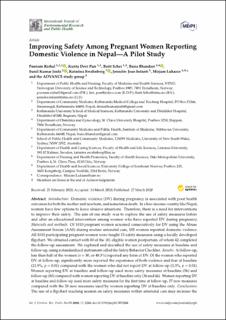| dc.contributor.author | Rishal, Poonam | |
| dc.contributor.author | Pun, Kunta Devi | |
| dc.contributor.author | Schei, Berit | |
| dc.contributor.author | Bhandari, Buna | |
| dc.contributor.author | Joshi, Sunil Kumar | |
| dc.contributor.author | Swahnberg, Katarina | |
| dc.contributor.author | Infanti, Jennifer | |
| dc.contributor.author | Lukasse, Mirjam | |
| dc.date.accessioned | 2020-04-03T08:02:07Z | |
| dc.date.available | 2020-04-03T08:02:07Z | |
| dc.date.created | 2020-03-27T22:13:55Z | |
| dc.date.issued | 2020 | |
| dc.identifier.citation | International Journal of Environmental Research and Public Health. 2020, 17 (2268), . | en_US |
| dc.identifier.issn | 1660-4601 | |
| dc.identifier.uri | https://hdl.handle.net/11250/2650197 | |
| dc.description.abstract | Introduction: Domestic violence (DV) during pregnancy is associated with poor health outcomes for both the mother and newborn, and sometimes death. In a low-income country like Nepal, women have few options to leave abusive situations. Therefore, there is a need for interventions to improve their safety. The aim of our study was to explore the use of safety measures before and after an educational intervention among women who have reported DV during pregnancy. Materials and methods: Of 1010 pregnant women screened consecutively for DV using the Abuse Assessment Screen (AAS) during routine antenatal care, 181 women reported domestic violence. All 1010 participating pregnant women were taught 15 safety measures using a locally developed flipchart. We obtained contact with 80 of the 181 eligible women postpartum, of whom 62 completed the follow-up assessment. We explored and described the use of safety measures at baseline and follow-up, using a standardized instrument called the Safety Behavior Checklist. Results: At follow-up, less than half of the women (n = 30, or 48.3%) reported any form of DV. Of the women who reported DV at follow-up, significantly more reported the experience of both violence and fear at baseline (21.9%, p = 0.01) compared with the women who did not report DV at follow-up (3.3%, p = 0.01). Women reporting DV at baseline and follow-up used more safety measures at baseline (56) and follow-up (80) compared with women reporting DV at baseline only (36 and 46). Women reporting DV at baseline and follow-up used more safety measures for the first time at follow-up, 57 new measures compared with the 28 new measures used by women reporting DV at baseline only. Conclusions: The use of a flipchart teaching session on safety measures within antenatal care may increase the number of safety measures women use to protect themselves during pregnancy and decrease the risks of adverse health effects of DV. | en_US |
| dc.language.iso | eng | en_US |
| dc.publisher | MDPI | en_US |
| dc.rights | Navngivelse 4.0 Internasjonal | * |
| dc.rights.uri | http://creativecommons.org/licenses/by/4.0/deed.no | * |
| dc.title | Improving Safety Among Pregnant Women Reporting Domestic Violence in Nepal—A Pilot Study | en_US |
| dc.type | Peer reviewed | en_US |
| dc.type | Journal article | en_US |
| dc.description.version | publishedVersion | en_US |
| dc.source.pagenumber | 13 | en_US |
| dc.source.volume | 17 | en_US |
| dc.source.journal | International Journal of Environmental Research and Public Health | en_US |
| dc.source.issue | 2268 | en_US |
| dc.identifier.doi | 10.3390/ijerph17072268 | |
| dc.identifier.cristin | 1804042 | |
| dc.description.localcode | © 2020 by the authors. Licensee MDPI, Basel, Switzerland. This article is an open access article distributed under the terms and conditions of the Creative Commons Attribution (CC BY) license (http://creativecommons.org/licenses/by/4.0/). | en_US |
| cristin.ispublished | true | |
| cristin.fulltext | original | |
| cristin.fulltext | original | |
| cristin.qualitycode | 1 | |

